Module 36: Solve Equations with Fraction or Decimal Coefficients
Learning Objectives
By the end of this section, you will be able to:
- Solve equations with fraction coefficients
- Solve equations with decimal coefficients
Solve Equations with Fraction Coefficients
Let’s use the General Strategy for Solving Linear Equations introduced earlier to solve the equation ![]() .
.
 |
|
| To isolate the |
 |
| Simplify the left side. |  |
| Change the constants to equivalent fractions with the LCD. |  |
| Subtract. |  |
| Multiply both sides by the reciprocal of |
 |
| Simplify. |  |
This method worked fine, but many students don’t feel very confident when they see all those fractions. So we are going to show an alternate method to solve equations with fractions. This alternate method eliminates the fractions.
We will apply the Multiplication Property of Equality and multiply both sides of an equation by the least common denominator of all the fractions in the equation. The result of this operation will be a new equation, equivalent to the first, but with no fractions. This process is called clearing the equation of fractions. Let’s solve the same equation again, but this time use the method that clears the fractions.
EXAMPLE 1
Solve: ![]() .
.
Solution
| Find the least common denominator of all the fractions in the equation. |  |
| Multiply both sides of the equation by that LCD, 8. This clears the fractions. |  |
| Use the Distributive Property. |  |
| Simplify — and notice, no more fractions! |  |
| Solve using the General Strategy for Solving Linear Equations. |  |
| Simplify. |  |
| Check: Let |
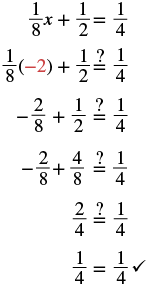 |
TRY IT 1.1
Solve: ![]() .
.
Show answer
![]()
TRY IT 1.2
Solve: ![]() .
.
Show answer
y = 3
Notice in (Figure) that once we cleared the equation of fractions, the equation was like those we solved earlier in this chapter. We changed the problem to one we already knew how to solve! We then used the General Strategy for Solving Linear Equations.
HOW TO: Solve Equations with Fraction Coefficients by Clearing the Fractions
- Find the least common denominator of all the fractions in the equation.
- Multiply both sides of the equation by that LCD. This clears the fractions.
- Solve using the General Strategy for Solving Linear Equations.
EXAMPLE 2
Solve: ![]() .
.
Solution
We want to clear the fractions by multiplying both sides of the equation by the LCD of all the fractions in the equation.
| Find the least common denominator of all the fractions in the equation. |  |
| Multiply both sides of the equation by 12. |  |
| Distribute. |  |
| Simplify — and notice, no more fractions! |  |
| Combine like terms. |  |
| Divide by 7. |  |
| Simplify. |  |
| Check: Let |
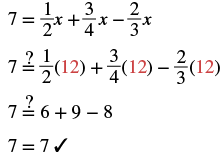 |
TRY IT 2.1
Solve: ![]() .
.
Show answer
v = 40
TRY IT 2.2
Solve: ![]() .
.
Show answer
u = −12
In the next example, we’ll have variables and fractions on both sides of the equation.
EXAMPLE 3
Solve: ![]() .
.
Solution
| Find the LCD of all the fractions in the equation. |  |
| Multiply both sides by the LCD. |  |
| Distribute. |  |
| Simplify — no more fractions! |  |
| Subtract |
 |
| Simplify. |  |
| Subtract 2 from both sides. |  |
| Simplify. |  |
| Divide by 5. |  |
| Simplify. |  |
| Check: Substitute |
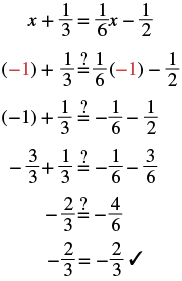 |
TRY IT 3.1
Solve: ![]() .
.
Show answer
a = −2
TRY IT 3.2
Solve: ![]() .
.
Show answer
c = −2
In (Figure), we’ll start by using the Distributive Property. This step will clear the fractions right away!
EXAMPLE 4
Solve: ![]() .
.
Solution
 |
|
| Distribute. |  |
| Simplify. Now there are no fractions to clear! |  |
| Subtract 1 from both sides. |  |
| Simplify. |  |
| Divide by 2. |  |
| Simplify. |  |
| Check: Let |
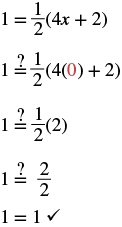 |
TRY IT 4.1
Solve: ![]() .
.
Show answer
p = −4
TRY IT 4.2
Solve: ![]() .
.
Show answer
q = 2
Many times, there will still be fractions, even after distributing.
EXAMPLE 5
Solve: ![]() .
.
Solution
 |
|
| Distribute. |  |
| Simplify. |  |
| Multiply by the LCD, 4. |  |
| Distribute. |  |
| Simplify. |  |
| Collect the |
 |
| Simplify. |  |
| Collect the constants to the right. |  |
| Simplify. |  |
| Check: Substitute |
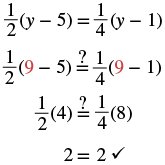 |
TRY IT 5.1
Solve: ![]() .
.
Show answer
n = 2
TRY IT 5.2
Solve: ![]() .
.
Show answer
m = −1
Solve Equations with Decimal Coefficients
Some equations have decimals in them. This kind of equation will occur when we solve problems dealing with money and percent. But decimals are really another way to represent fractions. For example, ![]() and
and ![]() . So, when we have an equation with decimals, we can use the same process we used to clear fractions—multiply both sides of the equation by the least common denominator.
. So, when we have an equation with decimals, we can use the same process we used to clear fractions—multiply both sides of the equation by the least common denominator.
EXAMPLE 6
Solve: ![]() .
.
Solution
The only decimal in the equation is ![]() . Since
. Since ![]() , the LCD is
, the LCD is ![]() . We can multiply both sides by
. We can multiply both sides by ![]() to clear the decimal.
to clear the decimal.
 |
|
| Multiply both sides by the LCD. |  |
| Distribute. |  |
| Multiply, and notice, no more decimals! |  |
| Add 50 to get all constants to the right. |  |
| Simplify. |  |
| Divide both sides by 8. |  |
| Simplify. |  |
| Check: Let |
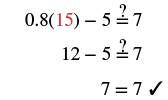 |
TRY IT 6.1
Solve: ![]() .
.
Show answer
x = 20
TRY IT 6.2
Solve: ![]() .
.
Show answer
x = 10
EXAMPLE 7
Solve: ![]() .
.
Solution
Look at the decimals and think of the equivalent fractions.
![]()
Notice, the LCD is ![]() .
.
By multiplying by the LCD we will clear the decimals.
 |
|
| Multiply both sides by 100. |  |
| Distribute. |  |
| Multiply, and now no more decimals. |  |
| Collect the variables to the right. |  |
| Simplify. |  |
| Collect the constants to the left. |  |
| Simplify. |  |
| Divide by 19. |  |
| Simplify. |  |
| Check: Let |
|
 |
TRY IT 7.1
Solve: ![]() .
.
Show answer
h = 12
TRY IT 7.2
Solve: ![]() .
.
Show answer
k = −1
The next example uses an equation that is typical of the ones we will see in the money applications in the next chapter. Notice that we will distribute the decimal first before we clear all decimals in the equation.
EXAMPLE 8
Solve: ![]() .
.
Solution
 |
|
| Distribute first. |  |
| Combine like terms. |  |
| To clear decimals, multiply by 100. |  |
| Distribute. |  |
| Subtract 15 from both sides. |  |
| Simplify. |  |
| Divide by 30. |  |
| Simplify. |  |
| Check: Let |
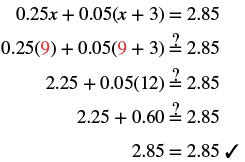 |
TRY IT 8.1
Solve: ![]() .
.
Show answer
n = 9
TRY IT 8.2
Solve: ![]() .
.
Show answer
d = 16
Key Concepts
- Solve equations with fraction coefficients by clearing the fractions.
- Find the least common denominator of all the fractions in the equation.
- Multiply both sides of the equation by that LCD. This clears the fractions.
- Solve using the General Strategy for Solving Linear Equations.
Practices Exercises
Exercises
Solve equations with fraction coefficients
In the following exercises, solve the equation by clearing the fractions.
| 1. |
2. |
| 3. |
4. |
| 5. |
6. |
| 7. |
8. |
| 9. |
10. |
| 11. |
12. |
| 13. |
14. |
| 15. |
16. |
| 17. |
18. |
| 19. |
20. |
| 21. |
22. |
| 23. |
24. |
Exercises
Solve Equations with Decimal Coefficients
In the following exercises, solve the equation by clearing the decimals.
| 25. |
26. |
| 27. |
28. |
| 29. |
30. |
| 31. |
32. |
| 33. |
34. |
| 35. |
36. |
| 37. |
38. |
| 39. |
40. |
Exercises
Everyday Math
| Coins 41. Taylor has |
Stamps 42. Travis bought |
Writing Exercises
| 43. Explain how to find the least common denominator of |
44. If an equation has several fractions, how does multiplying both sides by the LCD make it easier to solve? |
| 45. If an equation has fractions only on one side, why do you have to multiply both sides of the equation by the LCD? | 46. In the equation |
Answers
| 1. x = -1 | 3. y = -1 | 5. |
| 7. x = 4 | 9. m = 20 | 11. x = -3 |
| 13. |
15. x = 1 | 17. b = 12 |
| 19. x = 1 | 21. p = -41 | 23. |
| 25. y = 10 | 27. j = 2 | 29. x = 18 |
| 31. x = 18 | 33. x = 20 | 35. n = 9 |
| 37. d = 8 | 39. q = 11 | 41 d = 18 |
| 43. Answers will vary. | 45.Answers will vary. |
Attributions
This chapter has been adapted from “Solve Equations with Fraction or Decimal Coefficients” in Prealgebra (OpenStax) by Lynn Marecek, MaryAnne Anthony-Smith, and Andrea Honeycutt Mathis, which is under a CC BY 4.0 Licence. Adapted by Izabela Mazur. See the Copyright page for more information.

